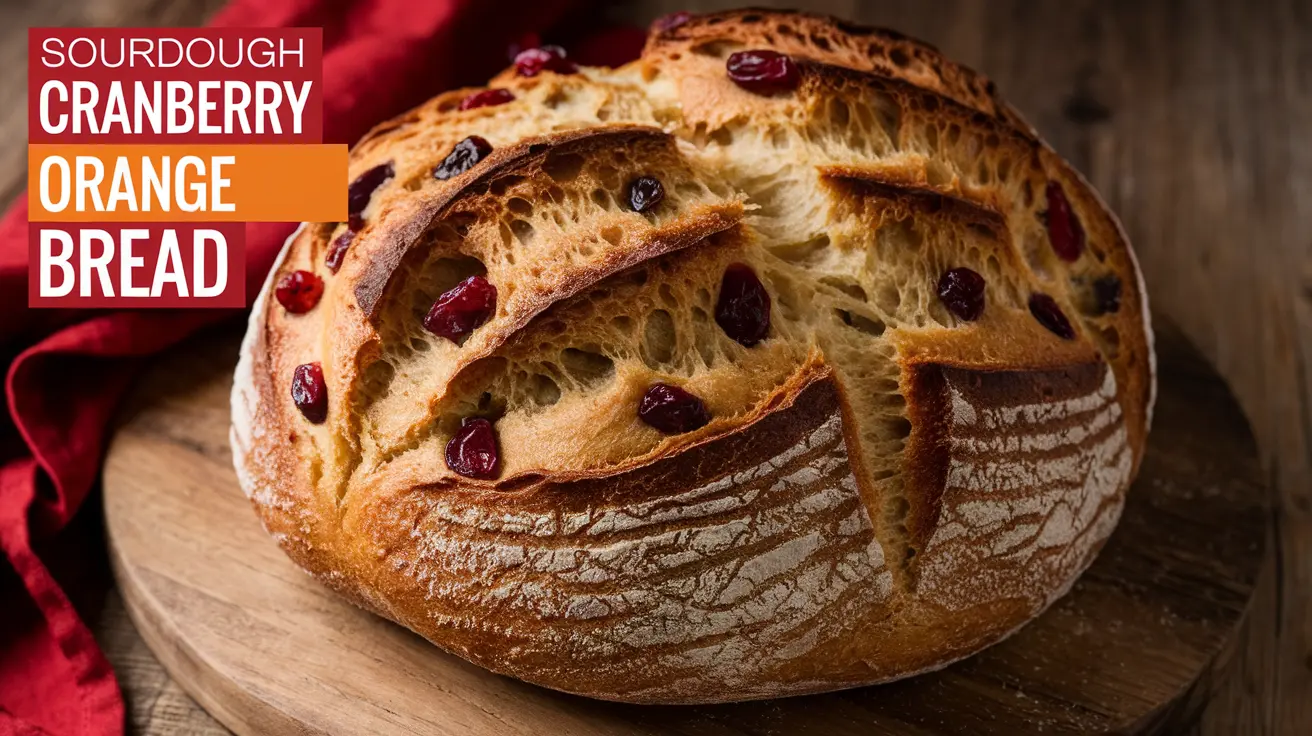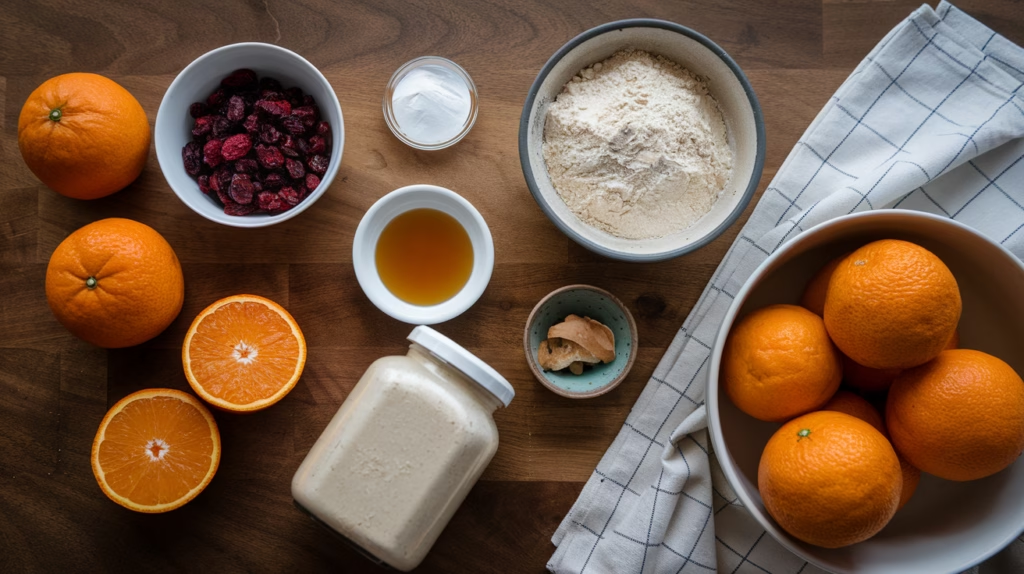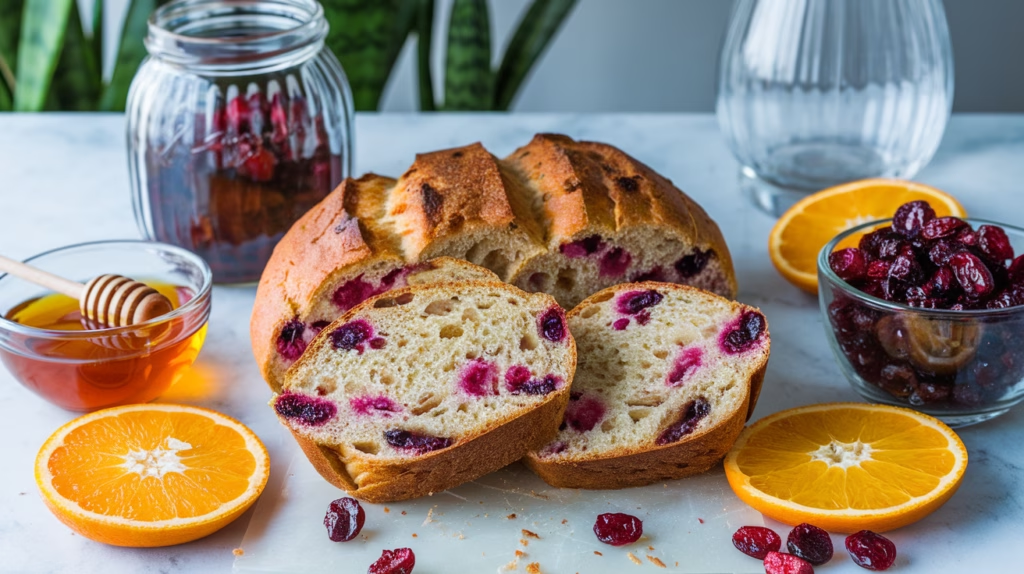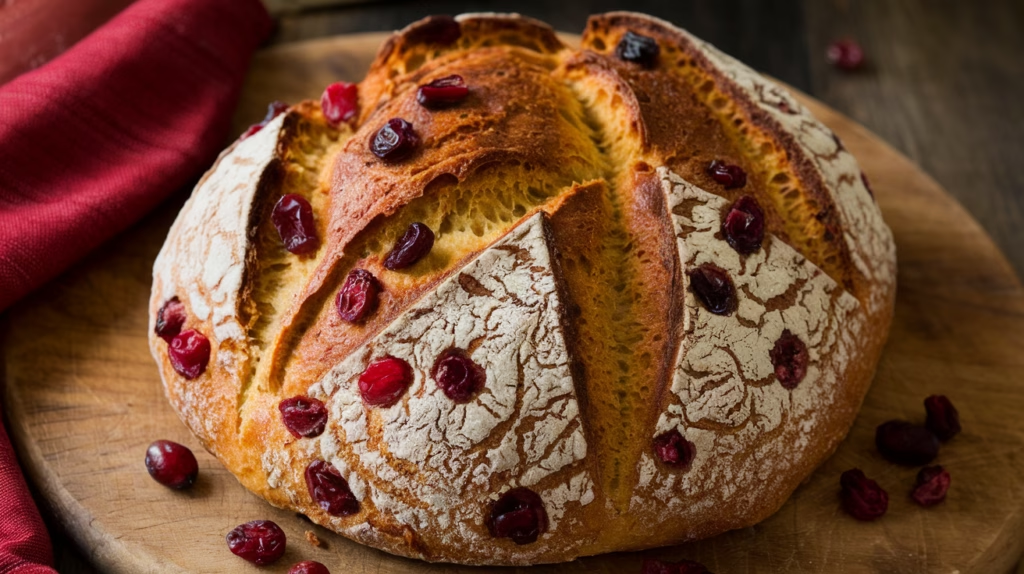
There’s something magical about the aroma of freshly baked bread wafting through your home. When that bread is studded with tart cranberries and infused with the zest of fresh oranges, it becomes more than just a loaf; it transforms into a symphony of flavors that dance on your palate. Whether you’re a seasoned baker or a novice in the world of sourdough, this comprehensive guide will lead you through each step to create a show-stopping Cranberry Orange Sourdough Bread.
Why Choose Cranberry Orange Sourdough?
Combining the natural tanginess of sourdough with the sweet and tart notes of cranberries and oranges results in a harmonious blend of flavors. This bread is not only delicious but also versatile. It’s perfect toasted with a pat of butter for breakfast, makes a delightful sandwich base, or can be enjoyed on its own as a snack.
Ingredients
Before diving into the process, let’s gather all the necessary ingredients:
- Sourdough Starter (50g)
- Role: Serves as the leavening agent, providing natural fermentation and imparting a tangy flavor to the bread.
- Alternative: If unavailable, you can use 25g of active dry yeast dissolved in 350g of water.
- Water (350g)
- Role: Hydrates the flour, activating gluten development and aiding in fermentation.
- Alternative: Filtered or bottled water is preferred to avoid chlorine, which can inhibit yeast activity.
- Honey (20g)
- Role: Adds a subtle sweetness and serves as food for the yeast, promoting fermentation.
- Alternative: Maple syrup or agave nectar can be used as substitutes.
- Bread Flour (500g)
- Role: Provides the necessary gluten structure for the bread.
- Alternative: Whole wheat flour can be used for a denser loaf, though it may require adjustments in hydration.
- Salt (10g)
- Role: Enhances flavor and regulates yeast activity.
- Alternative: Sea salt or kosher salt can be used; adjust quantities based on salt type.
- Orange Zest (from 1 whole orange)
- Role: Imparts a fresh, citrusy aroma and flavor.
- Alternative: Lemon zest can be used for a different citrus note.
- Orange Juice (from 1 whole orange, optional)
- Role: Adds moisture and a tangy flavor.
- Alternative: Water can be used if a more subtle flavor is desired.
- Dried Cranberries (100g)
- Role: Provides bursts of tartness and chewiness.
- Alternative: Dried cherries or raisins can be used as substitutes.

How To Preparer a Sourdough Starter
A sourdough starter is a mixture of flour and water that cultivates wild yeast and bacteria, essential for leavening and flavor in sourdough bread.
- Day 1: Mixing
- Ingredients:
- 100g whole grain flour (e.g., rye or whole wheat)
- 100g filtered water
- Instructions:
- In a non-reactive container, mix the flour and water until no dry bits remain.
- Cover loosely to allow airflow and let sit at room temperature (70-75°F or 21-24°C) for 24 hours.
- Ingredients:
- Day 2: Stirring
- Instructions:
- You may notice bubbles indicating fermentation. Stir the mixture to incorporate air.
- Cover and let sit for another 24 hours.
- Instructions:
- Days 3-7: Feeding and Maintenance
- Instructions:
- Each day, discard half of the starter to prevent over-acidity.
- Feed with 100g flour and 100g water, mixing thoroughly.
- Cover and let sit at room temperature for 24 hours.
- Repeat this process daily.
- Instructions:
- Readiness Check
- Instructions:
- After about a week, the starter should be bubbly, have a pleasant tangy aroma, and double in size within 4-6 hours of feeding.
- Perform the “float test”: drop a spoonful of starter into water; if it floats, it’s ready for baking.
- Instructions:
Additional Tips
- Flour Selection: Whole grain flours like rye or whole wheat are ideal for starters due to their higher nutrient content, which supports yeast growth. Serious Eats
- Water Quality: Use filtered or bottled water to avoid chlorine, which can inhibit yeast activity.
- Temperature: Maintain a consistent room temperature between 70-75°F (21-24°C) to encourage fermentation.
- Patience: Cultivating a starter takes time; consistency in feeding and temperature is key to success.

Step-by-Step Guide
1. Soak the Cranberries
To enhance the flavor and texture of the cranberries, soak them in the juice of one orange.
- In a small bowl, combine the dried cranberries and orange juice.
- Let them sit for about 30 minutes to plump up.
- If you prefer a more subtle orange flavor, you can soak the cranberries in water instead.
2. Autolyse (Premixing the Dough)
The autolyse process allows the flour to fully hydrate, leading to better gluten development.
- In a large bowl, mix the water and honey until combined.
- Add the sourdough starter and stir until it’s fully dissolved.
- Incorporate the bread flour and salt.
- Mix until a shaggy dough forms.
- Cover the bowl with a damp cloth and let the dough rest for 1 hour.
3. Incorporate Orange Zest and Cranberries
Adding the zest and cranberries infuses the dough with bursts of flavor.
- Drain the soaked cranberries.
- Gently fold the orange zest and drained cranberries into the dough until evenly distributed.
- Be careful not to overmix, as this can affect the dough’s structure.
4. Bulk Fermentation
This stage allows the dough to rise and develop flavor.
- Cover the bowl and let the dough rise at room temperature for 4-6 hours, or until it has doubled in size.
- The duration can vary based on room temperature and the activity of your starter.
5. Shape the Loaf
Shaping gives the bread its final form and prepares it for baking.
- Transfer the dough onto a lightly floured surface.
- Shape it into a tight round loaf by folding the edges into the center and then flipping it seam-side down.
- Place the shaped dough seam-side up into a floured proofing basket or bowl.
6. Proofing
Proofing is the final rise before baking, allowing the dough to expand and develop further flavor.
- Cover the dough and let it proof for 1-2 hours at room temperature.
- Alternatively, refrigerate it overnight for enhanced flavor and easier handling.
7. Preheat the Oven
A hot oven is crucial for achieving good oven spring and a crispy crust.
- About 30 minutes before baking, preheat your oven to 475°F (246°C).
- Place a Dutch oven inside to heat up.
8. Score and Bake
Scoring allows the bread to expand properly during baking.
- Carefully turn the dough onto a piece of parchment paper.
- Using a sharp blade or lame, score the top of the loaf with a design of your choice.
- Transfer the dough (on the parchment) into the preheated Dutch oven, cover with the lid, and bake for 20 minutes.
- Remove the lid and continue baking for an additional 20-25 minutes, or until the crust is deep golden brown.
9. Cool
Cooling ensures the interior sets properly and enhances the bread’s flavor.
- Carefully remove the bread from the oven and let it cool on a wire rack for at least 1 hour before slicing.
- Cutting too early can result in a gummy texture, so resist the temptation!
Tips for Success
- Active Starter: Ensure your sourdough starter is active and bubbly before beginning. This is crucial for a good rise.
- Room Temperature: Be mindful of your kitchen’s temperature, as it can affect fermentation times.
- Hydration: If the dough feels too sticky, you can add a bit more flour; if it’s too dry, add a little water.
- Experiment: Feel free to add nuts like walnuts or spices like cinnamon for a different flavor profile.

How should I store the bread?
Proper storage of your freshly baked Cranberry Orange Sourdough Bread is essential to maintain its flavor and texture. Here are some effective methods to keep your bread fresh:
1. Paper Bag or Cloth Bag
Storing bread in a paper or cloth bag allows for adequate air circulation, helping to maintain the crust’s crispness while preventing excessive moisture buildup that can lead to mold. This method is particularly suitable for crusty sourdough loaves.
2. Bread Box
A bread box provides a controlled environment with proper air circulation, preventing the bread from drying out too quickly while avoiding excess moisture. This storage method can extend the freshness of your bread by an extra day or more.
3. Beeswax Wraps
Beeswax wraps are breathable yet retain some moisture, making them a good option for covering the cut side of the bread. However, they may lead to a chewier crust.
4. Freezing
For longer-term storage, freezing is an excellent option. Once the bread has fully cooled, slice it and place the slices in a plastic bag or airtight container before freezing. This method preserves the bread’s quality, and you can toast slices directly from the freezer as needed.
Storage Tips:
- Avoid Refrigeration: Storing bread in the refrigerator accelerates staling due to the crystallization of starch molecules at cooler temperatures. It’s best to keep bread at room temperature in a suitable storage method. The Sun
- Cool Completely: Ensure the bread is completely cooled before storing to prevent condensation, which can lead to a soggy crust or mold development. Farmhouse on Boone
- Environment Considerations: In humid climates, monitor stored bread closely for mold. In such cases, freezing may be the most effective storage method. Simply Recipes
By selecting the appropriate storage method based on your preferences and environment, you can enjoy the delightful taste and texture of your Cranberry Orange Sourdough Bread for several days.

FAQs
What if I don’t have a Dutch oven?
You can bake the bread on a preheated baking stone or sheet. To create steam, place a tray of water at the bottom of the oven or mist the oven walls with water before baking.
Can I use fresh cranberries instead of dried?
Yes, but fresh cranberries have more moisture, which can affect the dough’s hydration. If using fresh, consider reducing the water slightly and chopping the cranberries to distribute them evenly.

Cranberry Orange Sourdough Bread: The Best Recipe
- Total Time: 5-7 hours (including fermentation)
- Yield: 1
Description
The Orange Cranberry Sourdough Bread recipe combines tangy cranberries and citrusy orange flavor with the signature sourdough base. It’s a festive bread, perfect for the holiday season or any time you want a zesty, sweet loaf.
Ingredients
- 50g sourdough starter (fed and bubbly)
- 350g water
- 20g honey
- 500g bread flour
- 10g salt
- Zest of 1 whole orange
- Juice of 1 whole orange (optional)
- 100g dried cranberries
Instructions
- Soak the Cranberries: In a small bowl, soak 🍇 dried cranberries in the 🍊 juice of one orange (optional) to plump them up. Set aside.
- Autolyse (Premixing the Dough): In a large bowl, mix 💧 350g water and 🍯 20g honey until combined. Add 🍞 50g sourdough starter and stir until dissolved. Add 🌾 500g bread flour and 🧂 10g salt. Mix until a shaggy dough forms. Cover the bowl and let the dough rest for 1 hour.
- Incorporate Orange Zest and Cranberries: Drain the soaked 🍇 cranberries. Gently fold the 🍊 orange zest and drained cranberries into the dough until evenly distributed.
- Bulk Fermentation: Cover the bowl and let the dough rise at room temperature for 4-6 hours, or until it has doubled in size.
- Shape the Loaf: Transfer the dough onto a lightly floured surface.Shape it into a tight round loaf. Place the shaped dough seam-side up into a floured proofing basket or bowl.
- Proofing: Cover and let it proof for 1-2 hours at room temperature, or refrigerate overnight for enhanced flavor.
- Preheat the Oven: About 30 minutes before baking, preheat your oven to 475°F (246°C) with a Dutch oven inside.
- Score and Bake: Carefully turn the dough onto a piece of parchment paper. Score the top of the loaf with a sharp blade. Transfer the dough (on the parchment) into the preheated Dutch oven, cover with the lid, and bake for 20 minutes. Remove the lid and continue baking for an additional 20-25 minutes, or until the crust is deep golden brown.
- Cool: Carefully remove the bread from the oven and let it cool on a wire rack for at least 1 hour before slicing.
- Prep Time: 1 hour (active)
- Cook Time: 45 minutes
- Category: bread
Nutrition
- Serving Size: 16 slices
- Calories: 138 kcal per slice
- Sugar: 7.5 g
- Sodium: 150 mg
- Fat: 2.5 g
- Saturated Fat: 0.5 g
- Unsaturated Fat: 2 g
- Trans Fat: 0 g
- Carbohydrates: 28.7 g
- Fiber: 1.4 g
- Protein: 4.3 g
- Cholesterol: 0 mg





